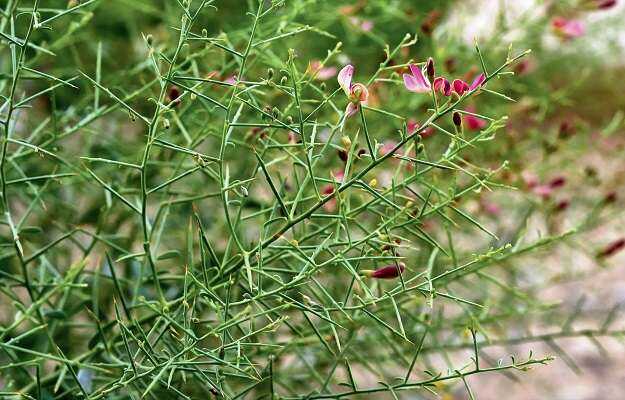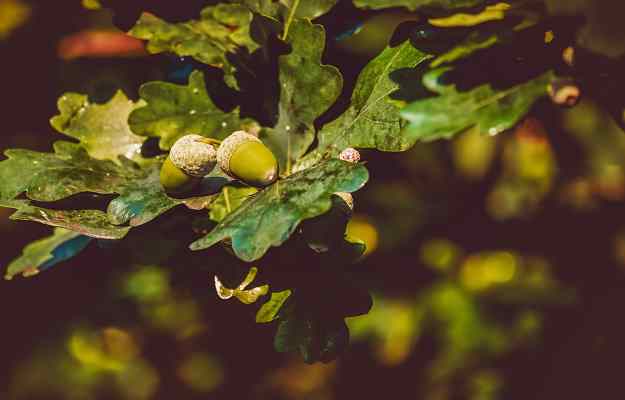Yavasa is a plant that is well known in folk medicine, especially Iranian traditional medicine, for its wide range of therapeutic and medicinal properties. The herb is suggested to contain anti-inflammatory, antioxidant and antimicrobial compounds and is known to be a good diuretic and expectorant.
In India, Yavasa is imported from Afghanistan and Iran and is sold under the name torajabin. Here, it is used mainly in the preparation of laxatives, diuretics, sweetening agents and cosmetics.
Alhagi is also grazed on by livestock.
Some facts about yavasa:
- Botanical name: Alhagi camelorum, Alhagi pseudalhagi and Alhagi maurorum
- Family: Fabaceae
- Common name: Camel thorn, Caspian manna, Persian manna, Hebrew manna, Moor’s alhagi
- Hindi name: Bharbhara, Jawasa
- Sanskrit name: Yavaska
- Parts used: Whole plant
- Geographical distribution: Yavasa is native to the Middle East, North Africa and South-East Europe. It is also found in Asia (including India, China, Pakistan, Afghanistan, China), Europe (including Russia, Cyprus and Cezh Republic), North America and Australia. In India, yavasa plants are found mainly in Uttar Pradesh, Gujarat, Punjab and Rajasthan.
- Interesting fact: Yavasa is mentioned as a source of sweet manna in the Holy Quran. As per the Quran, manna is a divine food substance provided by God to mankind. Alhagi is known as manna in Iran.
How to identify yavasa
Yavasa is a perennial shrub with long rhizomatous roots, which usually show lateral roots or scars left by those roots. The plant bears aerial and branched stems with branches arising from the stout and cylindrical underground crown. These branches have swollen nodes with a rough and spiny surface, are greenish to brown in colour and have simple leaves that are arranged alternately on them. The leaves are ovate to lance-shaped and hairy, with a silvery hue on them. Yavasa plants bear tiny pinkish-purple to red-maroon flowers. The fruits of this plant are red to brown in colour and have a narrow beak at their end.
Yavasa health benefits
Yavasa is traditionally used for the treatment of several diseases ranging from gastrointestinal conditions and urinary tract disorders to kidney stones and asthma. It is indicated to have anti-ulcerogenic, pain-reducing and antidiarrheal properties. Though not much clinical research is available regarding the health benefits of yavasa, here are some science-backed health benefits of this plant that you should know about.
Antimicrobial properties of yavasa/camel thorn plant
Yavasa plant has long been used in Iranian traditional medicine for the treatment of infections.
An in vivo study indicated that methanol extract of A. camelorum flowers possesses potent antimicrobial activity against the bacteria Escherichia coli (causes dysentery and diarrhoea) and Staphylococcus aureus (causes skin infections).
In another study, both the leaves and flower extracts of yavasa plants were found to have antimicrobial effects that were positively associated with the antimicrobial potential of the plant.
According to a study published in the journal Medicinal plants with antimicrobial effects, A. mauroram extract inhibits the growth of pathogenic bacteria including Klebsiella pneumoniae, Pseudomonas aeruginosa, E. coli and Staphylococcus aureus.
The plant has also been found to be effective against fungi like Fusarium, Aspergillus and Trichoderma.
Read more: Fungal infections symptoms
Yavasa/camel thorn effects on liver
Alhagi maurorum is used for the treatment of various liver disorders in folk medicine. Though there are no clinical studies to prove the effectiveness of the herb on the liver, some preclinical studies have indicated the hepatoprotective effects of Alhagi.
In a study done on rat models, it was found that the ethanol extract of A. camelorum plant improves liver function.
In another animal study, administration of Alhagi ethanol extract was indicated to have protective effects against liver injury. As per the study, the herb was helpful in reducing cell death and inflammation in liver cells.
According to a study published in the peer-reviewed journal Pharmacognosy magazine, a group of compounds called flavonoids present in A. maurorum are responsible for the hepatoprotective effects of this herb.
However, quite contrary to all this evidence, an in vivo study noted no effect in the liver health on the administration of Alhagi extract.
Read more: Foods to improve liver health
Yavasa/camel thorn benefits for the gastrointestinal system
Traditionally, Alhagi species are used in the treatment of various gastrointestinal conditions including stomach pain, diarrhoea and dysentery. It is also used to manage constipation, low appetite and bloating.
In a study done in Egypt, a group of researchers suggested that A. maurorum possesses anti-inflammatory and anti-ulcer effects.
Another in vivo study (done on rats) suggested that A. camelorum has a dose-dependent protective effect on gastric ulcers.
According to a research study published in the Wulfenia journal, methanol extract of A. maurorum reduces the risk of gastric-ulcers in animal models.
However, since no clinical study has yet been conducted to study the dosage and safety of Alhagi extract on human gastric mucosa, it is best that you consult an experienced ayurvedic doctor before using this herb for any gut-related issue.
Read more: How to improve digestion
Antioxidant effects of yavasa/camel thorn plant
Antioxidants are natural compounds that help our body fight free radicals (unstable molecules formed during normal metabolism). With age or due to poor lifestyle, free radicals tend to accumulate in the body, leading to a condition known as oxidative stress. Oxidative stress gradually deteriorates organ function and may also lead to metabolic diseases and premature ageing.
Now, methanol extract of A. maurorum plants has shown to possess potent antioxidant properties in a research conducted in Iraq. As per the study, the properties are due to the presence of various compounds including phenols and flavonoids in the plant extracts; the greater the antioxidant effects, the better are the antimicrobial properties of Alhagi plant.
In another study, the flavonoids present in A. maurorum plant were suggested to be responsible for its antioxidant activity.
Similar results were obtained in another lab study conducted on A. camelorum. However, along with flavonoids, the researchers also indicated that phenolics may be adding to the antioxidant effect of the plant.
Alhagi effects on kidney stones
Extracts of Alhagi maurorum plant are used by some local populations for the treatment and management of kidney stones.
A phytochemical analysis done on Alhagi plant indicated that various bioactive compounds including flavonoids, tannins and triterpenes may be responsible for its benefits in kidney stones.
On the contrary, a study done in Iran suggested that the hydrophilic extract of Alhagi has no effect on the rate of calcium oxalate stone formation in kidneys.
However, if you have kidney stones, it is best not to self medicate and instead talk to your doctor about the effectiveness of this herb.
Read more: Kidney stones diet
Yavasa benefits in diabetes
Several studies indicate that Alhagi possesses hypoglycemic (reducing blood sugar levels) potential, suggesting the possible role of this herb in the management of diabetes.
In a study conducted on rats, regular administration of a specific dose of A. camelorum was found to help reduce the rate of hyperglycemia (high blood sugar levels) associated with diabetes.
Another animal study found that A maurorum ingestion reduces blood glucose, blood cholesterol levels and oxidative stress caused by diabetes in rats.
As per a study published in the American Journal of Ethnomedicine, the anti-diabetic potential of Alhagi pseudalhagi can be attributed to various phytonutrients present in the plant including glycosides, tannins and alkaloids.
Read more: Exercises for diabetes
Other health benefits of yavasa
Apart from the ones mentioned above, the following are some of the other benefits of yavasa plant:
- Both in vitro and in vivo studies suggest that yavasa plants have anti-inflammatory and analgesic effects. Experts suggest that Alhagi maurorum may be useful in the management of inflammatory diseases.
- Alcoholic extract of A. maurorum is suggested to possess anti-diarrheal properties.
- In an animal study, methanol extracts of A. maurorum are indicated to have a diuretic effect (increase the amount of salt and water released in urine).
- Traditionally, leaves of Alhagi plant smoked for the treatment of asthma, leaf paste and crushed flowers are used as a topical application for piles and Alhagi leaves are taken orally for reducing fever.
- Alhagi leaves are also used for the treatment of headache and chest pain.
- The plant is used for the treatment of rheumatism in some parts of the world.
- A. maurorum extracts have been found to have antitumor activity against various cancer cell lines.
How to use yavasa
Yavasa is traditionally used in the form of a powder, paste and decoction for the management of various health conditions.
It is taken both orally and used as a topical formulation. It makes an important part of various ayurvedic formulations including Gandharvahastadi Kwath Churṇa, Chinnodbhavadi Kvatha Churṇa and Arimedadi Taila.
Talk to your doctor to know what is the right way to use yavasa as per your health condition and need.
Yavasa dosage
As per an article published in the International Journal of Herbal Medicine, 20-50 g of yavasa powder can be taken safely in the form of a decoction. Also, up to 2000-4000 mg/Kg of ethanol extract of this plant is suggested to be safe for human consumption.
However, the correct dosage for you would depend on your age and health. Consult an experienced ayurvedic practitioner to know the dose of this herb that would suit you best.
Yavasa side effects
The following are some of the side effects of yavasa plant:
- There is no proof of the safety of yavasa consumption or use during pregnancy or breastfeeding. If you are expecting or are a nursing mother, it is best to avoid using this herb.
- If you have a chronic health condition or are taking medications for one, talk to your doctor before taking yavasa in any form.
- While yavasa plants are known to have hypoglycemic effects, diabetic people should not use this herb without consulting their doctor about the potential effects or benefits of yavasa on their health.
Find Ayurvedic Doctor in cities
Doctors for Yavasa benefits and side effects

Dr. Megha Sugandh
Ayurveda
6 Years of Experience

Dr. Nadeem
Ayurveda
3 Years of Experience

Dr.Ashok Pipaliya
Ayurveda
12 Years of Experience

Dr. Harshaprabha Katole
Ayurveda
7 Years of Experience
References
- Nishanbaev Sabir, Shamyanov I.D. Specificity and metabolism of plants of the genus Alhagi. Biological activity and adaptive role. International Symposium on the Chemistry of Natural Compounds. 2019 October.
- Srivastava Bhavana, et al. Alhagi pseudalhagi: a review of its phyto-chemistry, pharmacology, folklore claims and Ayurvedic studies. International Journal of Herbal Medicine. 2014; 2(2): 47-51.
- Al-Snafi Ali Esmail. Alhagi maurorum as a potential medicinal herb: An Overview. International Journal of Pharmacy Review and Research. 2015; 5(2): 130-136.
- Laghari Abdulm, Memon Shahabuddin, Nelofar Aisha, Khan Khalid Mohammed. Determination of Volatile Constituents and Antimicrobial Activity of Camel Thorn (Alhagi camelorum) Flowers. Analytical Letters. 2014; 47(3).
- Sulaiman Ghassan. Antimicrobial and cytotoxic activities of methanol extract of Alhagi maurorum. African Journal of Microbiology Research. 2013; 7(16).
- Ml Al-Kamel, Al-Kamel Ml, Al-Snafi Ali Esmail. Antibacterial effect of the phenolic extract of Alhagi maurorum. IOSR Journal of Pharmacy. 2019; 9(9): 47-55.
- Dhaniya Shilpa, Parihar Suman Kumari. Antimicrobial potential of Alhagi maurorum against clinically important microbes. International Journal of Botany Studies. 2018; 3(2).
- Nabiyouni fatemeh, et al. The effects of ethanol extract of Alhagi camelorum on hepatic and renal functions in streptozotocin-induced diabetic rats. Experimental animal biology. 2016; 5(1): 31-38.
- Tahmoores Shahrivar, Mokhtari Mokhtar, Vally Alipour. The effects of Alhagi maurorum on the liver properties and histological changes in diabetic rats. Gazzetta Medica Italiana Archivio per le Scienze Mediche. 2018; 177(12): 718-25.
- Al-Saleem Muneera S.M., et al. Antioxidant flavonoids from Alhagi maurorum with hepatoprotective effect. Pharmacognosy Magazine. 2019; 15(65): 592-599.
- Tavassol Amir Parviz, et al. Phytochemistry and therapeutic effects of Alhagi spp. and Tarangabin in traditional and modern medicine: a review. Journal of Hermed Pharmacology. 2020; 9(2).
- Asghari Mohammad Hossein, et al. A systematic and mechanistic review on the phytopharmacological properties of Alhagi species. Ancient Sci Life. 2016; 36: 65-71.
- Shaker E, Mahmoud H, Mnaa S. Anti-inflammatory and anti-ulcer activity of the extract from Alhagi maurorum (camelthorn). Food Chem Toxicol. 2010 Oct; 48(10): 2785-90. PMID: 20633591.
- Gharib-Naseri M. K., Mard S. A. Gastroprotective effect of Alhagi camelorum on experimental gastric ulcer in rats. 2007.
- Atta, A. H, et al. Alhagi Maurorum Methanol Extract ameliorates gastric ulceration and liver injury in a rat model. Wulfenia Journal. 2018; 25(12).
- Ghassan M. Sulaiman. Antimicrobial and cytotoxic activities of methanol extract of Alhagi maurorum. African Journal of Microbiology Research. Antimicrobial and cytotoxic activities of methanol extract of Alhagi maurorum. 2013; 7(16): 1548-1557.
- Al-Saleem Muneera S M., et al. Antioxidant flavonoids from Alhagi maurorum with hepatoprotective effect. Pharmacognosy Magazine. 2019; 15(65): 592.
- Demir Ezgi, et al. Antioxidant Activity of Alhagi camelorum Phenolics Extracted by Automated and Standard Extraction Techniques. Separation Science and Technology. 2015; 50(4).
- Fakhri Kamran Pashayi, Adelzadeh Parvaneh. Pharmacology and Medicinal Aspects of Plants listed in Holey Quran; Alhagi (Alhagi maurorum). Bulletin of Environment, Pharmacology and Life Sciences. 2013; 2(6): 19-22.
- Varshochi Fatemeh, Asadollahi Khairollah. Alhagi; traditional and modern medicine effective against kidney stones. Journal of Nephropharmacology. 2017; 6(1): 15–16. PMID: 28197523.
- Nabiyouni Fatemeh, Vaezi Gholamhasan, Malekirad Ali Akbar. Hypoglycaemic and hypolipidemic activities of Alhagi camelorum in streptozotocin-induced diabetes in Wistar rats. Archives of Physiology and Biochemistry. 2019.
- Sheweita S. A., et al. Changes in Oxidative Stress and Antioxidant Enzyme Activities in Streptozotocin-Induced Diabetes Mellitus in Rats: Role of Alhagi maurorum Extracts. Oxid Med Cell Longev. 2016; 2016: 5264064. PMID: 26885249.
- Sachan Anupam K, Rao Ch. V., Sachan Nikhil K. Extraction and Evaluation of Hypoglycemic and Wound Healing Potential of HydroEthanolic Extract of Alhagi pseudalhagi Wild. Aamerican Journal of Ethnomedicine. 2017; 4(2).
- Nadheerah Falih Neamah. A Pharmacological Evaluation of Aqueous Extract of Alhagi Maurorum. Global Journal of Pharmacology. 2012; 6(1): 41-46.
- Abdulbary Meison. Detection about the Anti-Inflammatory Effect in Alcoholic Extract of Alhagi maurorum in vitro. International Journal for Research in Applied Sciences and Biotechnology. 2018; 5(5).
- Ahmad Nabeela, Bibi Yamin, Saboon, Raza Iqra. Traditional uses and pharmacological properties of Alhagi maurorum: A review. Asian Pacific Journal of Tropical Disease. 2015; 5(11):856-861.














